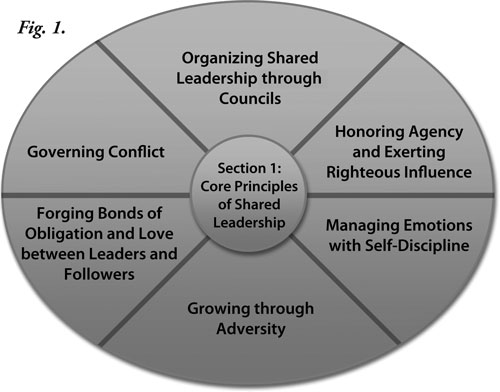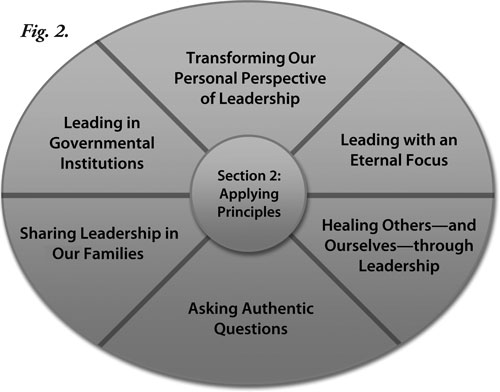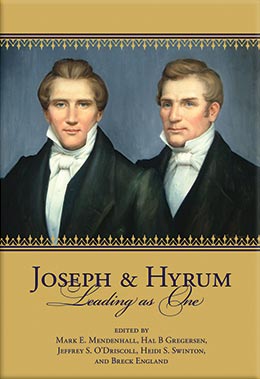Introduction
Mark E. Mendenhall, Hal B Gregersen, Jeffrey S. O’Driscoll, Heidi S. Swinton, and Breck England, “Introduction,” in Joseph and Hyrum—Leading as One ed. Mark E. Mendenhall, Hal B Gregersen, Jeffrey S. O’Driscoll, Heidi S. Swinton, and Breck England, (Provo, UT: Religious Studies Center, Brigham Young University; Salt Lake City: Deseret Book, 2010), v–x.
“In Life They Were Not Divided, and in Death They Were Not Separated!”
The gospel of Jesus Christ unfolded through the united leadership of Joseph Smith and that of his ever-faithful older brother Hyrum. “I rejoice in my acquaintance with the Prophet Joseph, and with his brother Hyrum also,” remembered Mary Ann Stearns Winters, “for one is not complete without the other—they were nearly always together, and are inseparably connected in mind—Joseph and Hyrum—names ever dear to the faithful.” [1]
Joseph and Hyrum Smith were virtually inseparable in the work of the Lord. Excepting the demands of Church and missionary travel, they were almost always together. They were together when Brigham Young first met them. They were together when Wilford Woodruff first met them. And that is how many new converts upon their arrival in Nauvoo recorded their first meeting with the Prophet Joseph—that they met Joseph and Hyrum at the same time because they were together. [2]
Theirs is not a story simply of togetherness bound by common experience; theirs is one of shared leadership manifest in commitment, loyalty, tenderness, unequivocal love, and unfailing allegiance to the Lord. From the scriptures we read, “In life they were not divided, and in death they were not separated!” (D&C 135:3).
No wonder Joseph said of his trusted partner in the work of the Restoration, “I could pray in my heart that all my brethren were like unto my beloved brother Hyrum, who possesses the mildness of a lamb, and the integrity of a Job, and in short, the meekness and humility of Christ; and I love him with that love that is stronger than death, for I never had occasion to rebuke him, nor he me.” [3]
Said Hyrum of his brother, “There were prophets before, but Joseph has the spirit and power of all the prophets.” [4]
By revelation through Joseph Smith, Hyrum was called and ordained to the priesthood and standing once held by Oliver Cowdery. Hyrum Smith received a double portion; not only was he called to become the Patriarch to the Church, which was his birthright, but at the same time, the Lord said to him, “From this time forth I appoint unto him that he may be a prophet, and a seer, and a revelator unto my church, as well as my servant Joseph” (D&C 124:94).
Joseph and Hyrum loved one another through sickness, imprisonment, persecution, and death. Their leadership is a model for all Latter-day Saints. In our families, our wards and branches, our places of employment, and our community service, we can strive to emulate the leadership principles demonstrated by Joseph and Hyrum Smith. In so doing, we will be better parents, managers, administrators, coaches, and teachers. We will better magnify our callings and increase the pace and progress of the kingdom.
This book grew out of a two-day conference of experts in both leadership and Church history. We wanted to study more deeply Joseph and Hyrum’s friendship and, more particularly, their shared leadership.
Learning from one another, we came to more fully appreciate how Joseph Smith, while the Prophet and President of the Church, relied on others—especially Hyrum—for counsel, support, and leadership. “It is an error,” said Elder M. Russell Ballard, “to put Joseph as a stand-alone figure. In Joseph’s greatest hours of need, Hyrum was there.” [5]
At the close of the conference, the participants desired to learn more and to share additional insights into the shared leadership of these two brothers who gave their lives in the service of the Lord. We discovered that their examples, teachings, and legacy offer more valuable insights into leadership philosophy and practice than most academic research in scholarly journals or how-to books sold at bookstores around the world.
In evaluating Joseph and Hyrum’s work and contributions, we may stand back and look at what they did and see them organizing and operating a Church, teaching, speaking, and building temples and towns. If we look at their efforts, we stand at a distance. But when we began to assess and discuss how they worked, how they led, how they encouraged and supported and sustained, we began to see them differently. This book describes their leadership through that lens.
We could have looked at these two prophets through many different lenses. Initially, we wondered what Joseph and Hyrum’s leadership would look like through the lens of modern management theory. But the lessons we learned transcended those models. We also considered an opposite approach: exploring the Smiths’ leadership experiences without referring to management theory or even drawing our own conclusions. But their story so enhanced our understanding of leadership science that we felt the need to share those insights. At one point we were tempted to build a new framework of leadership theory based on Joseph and Hyrum, but we abandoned that idea for fear of confining the prophets within a cramped compartment of our own making.
In the end, we decided simply to write from our hearts as Latter-day Saints who honor and love these men and who happen to be scholars. Each chapter represents a personal experience in learning from Joseph and Hyrum Smith about leadership that edifies. This book is really a labor of love—each of us desired simply to share with you what we found out and felt as we studied lessons in leadership from the founding prophets of the Restoration. There is, of course, some repetition in the stories and principles presented; the repetition serves to underscore and reemphasize the importance of what each author presents.
After we gathered everyone’s contributions and pondered their content, we decided to divide the book into two general sections. Section 1 contains chapters that focused on several core principles of shared leadership that were demonstrated and taught by Joseph and Hyrum: honoring agency and exerting righteous influence, managing emotions with self-discipline, growing through adversity, forging bonds of obligation and love, governing conflict, and organizing through councils. These core principles are illustrated in figure 1.

Section 2 highlights chapters that focused on opportunities we all have to actively practice and apply the core principles of shared leadership discussed in section 1. These chapters discuss how Joseph and Hyrum learned to apply these principles in their lives. The chapters in section 2 explore how we can transform our personal perspective of leadership, lead with an eternal focus, heal and bless others through our leadership, learn and grow by asking authentic questions, share leadership in the home, and lead in the governmental arena. By understanding and following these principles as Joseph and Hyrum did in their lives, we can create more edifying leadership in our homes, our Church service, and our professional lives (see fig. 2 below).

The book concludes with a tribute to Joseph and Hyrum’s shared leadership—and a call for each of us to carry on their legacy. The legacy of these two men transcends date, time, and place. Their lives and teachings are filled with lessons and skills we can easily apply today. As leaders they held firm to their convictions, roused the hearts and minds of men and women in many varied walks of life and countries, and left legacies sufficient to stamp them as two of the most remarkable and influential men of the nineteenth century.
The Editors
Notes
[1] Mary Ann Winters, “Joseph Smith, the Prophet,” Young Woman’s Journal, December 1905, 557, quoted in Jeffrey S. O’Driscoll, Hyrum Smith: A Life of Integrity (Salt Lake City: Deseret Book, 2003), 227.
[2] O’Driscoll, Hyrum Smith, 225.
[3] Personal Writings of Joseph Smith, comp. and ed. Dean C. Jessee, 2nd ed. rev. (Salt Lake City: Deseret Book, 2002), 138.
[4] Joseph Smith, History of the Church of Jesus Christ of Latter-day Saints, ed. B. H. Roberts, 2nd ed. rev. (Salt Lake City: Deseret Book, 1957), 6:346.
[5] Heidi S. Swinton, American Prophet: The Story of Joseph Smith (Salt Lake City: Deseret Book, 1999), 117.
